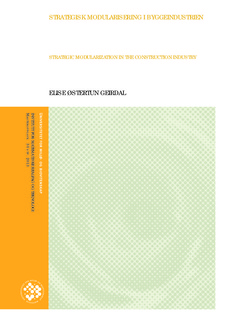| dc.description.abstract | SAMMENDRAG; Temaet for denne oppgaven er hva strategisk modularisering er og i hvilken grad det benyttes i byggeindustrien.
Strategisk modularisering er bygget opp rundt tre søyler hvor målet er å øke kapasiteten og redusere kompleksitet ved å integrere taus kunnskap tidlig på modul og leverandørnivå mellom modulintegrator og modulleverandør. Når dette fungerer kan to eller flere uavhengige moduler kommunisere med hverandre gjennom standardiserte grensesnitt som bidrar til bedre resultat og ytelse.
I denne kvalitative tverrsnittsstudien ble semistrukturerte dybdeintervjuer anvendt. Fem personer ble intervjuet. Informantene var alle ledere på ulike nivåer med ulik erfaring i byggeindustrien. Resultatene er basert på deres meninger og oppfatninger knyttet til temaet.
Resultatene viser at mange faktorer som presentert i strategisk modularisering benyttes til en viss grad i byggeindustrien. Blant disse er faktorer som kostnadsreduksjon, redusert tidsbruk, bruk av moduler og elementer og godt samarbeid som inngår i strategisk modulariserings første søyle, modulær produktarkitektur. Med hensyn til strategisk modulariserings andre søyle, taus kunnskap, viser funnene at i byggeindustrien er overføring og artikulering av taus kunnskap vel så viktig internt i et firma som mellom ulike aktører i et byggeprosjekt. I den tredje søylen, forsyningskjeden viser resultatene at valg av leverandører i all hovedsak baseres på pris og i mindre grad av partnering og tett samarbeid.
Undersøkelsen viser at en del faktorer i strategisk modularisering er benyttet i byggeindustrien, samtidig som det viser at hensiktsmessig endring eller forbedring vil og positive resultater for kvalitet. ABSTRACT; The theme for this thesis is strategic modularization and to what extent strategic modularization is used in the construction industry.
Strategic modularization is built around three pillars where the goal is to increase capacity and reduce complexity by integrating tacit knowledge early in the module and supplier level between module integrator and module supplier. When this is functioning it enables two or more independent modules to communicate with each other through standardized interfaces that contribute to better results and performance.
In this cross-sectional study qualitative semistructured depth interviews was used. Five persons were interviewed. The informants were all managers at different levels with different experience in the construction industry. The results are based on their opinions and perceptions related to theme.
The results show that several of the factors used in strategic modularization are used to some extent in the building industry. These include factors such as cost reduction, reduced building time, close cooperation and the use of modules and elements as part of strategic modularizations first pillar, modular product architecture. According to the second pillar in strategic modularization, isolation of tacit knowledge, the results indicate that it is of great importance to transfer and articulate the tacit knowledge within the firm, but also between the firm and the projects participants. When it comes to the third pillar, integration of supply chain, the findings show that the suppliers primarily are chosen due to price and to a lesser extent by partnering and close cooperation.
The research show that factors in strategic modularization are used in the construction industry, still it shows that necessary change and improvement will give positive outcome for the quality. | no_NO |
